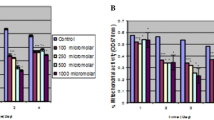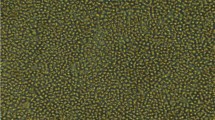Abstract
Triphenyltin acetate (TPTA), a triorganotin compound used in agriculture as a biocide, is immunotoxic in vivo and in vitro. The present study was undertaken to ascertain whether apoptosis might play a role in the TPTA toxicity in vitro. Mouse thymocyte primary cultures were exposed to 0, 4 and 8 μmol/L TPTA; methyl prednisolone (1 μmol/L) was used as a positive control. Cell aliquots were harvested after 0, 1, 2, 4, and 8 h and the presence of early or late apoptotic phenomena was checked by (a) morphological investigations; (b) spectrophotometric quantification of fragmented DNA and agarose gel electrophoresis; (c) cell flow cytofluorometry, using an annexin V-FITC kit; and (d) detection of in situ apoptosis by a colorimetric detection kit (Titer-Tacs). TPTA cytotoxicity was also evaluated using the trypan blue dye exclusion test. Morphological investigation indicated apoptosis and/or necrosis. After 8 h of incubation, cells exposed to 4 μmol/L TPTA showed an increase in DNA fragmentation (on electrophoresis), which was confirmed by spectrophotometry (p < 0.05). Flow cytofluorometry pointed out an early (p < 0.05) increase of annexin V-positive (apoptotic) cells in TPTA-exposed flasks, whereas at least partly contradictory, results were obtained with the Titer-Tacs kit. Overall, these results provide evidence that TPTA, at low concentrations (4 μmol/L) induces early and late apoptotic phenomena, whereas cells exposed to the highest concentrations (8 μmol/L) are likely to undergo necrosis rather than apoptosis.
Similar content being viewed by others
Abbreviations
- DMSO:
-
dimethyl sulfoxide
- EC:
-
European Commission
- EDTA:
-
ethylenediametetraacetic acid
- FCS:
-
fetal calf serum
- MPS:
-
methylprednisolone 21-hemisuccinate, sodium salt
- OD:
-
optical density
- OTs:
-
organotin compounds
- PBS:
-
phosphate buffer solution
- PI:
-
propidium iodide
- SD:
-
standard deviation
- TBE:
-
Tris boric acid and EDTA buffer solution
- TBTO:
-
bis(tri-n-butyltin) oxide
- TCDD:
-
2, 3, 7, 8-tetrachlorodibenzo-p-dioxin
- TdT:
-
deoxynucleotidyltransferase
- TOT:
-
triorganotin
- TPTA:
-
triphenyltin acetate
- TUNEL:
-
deoxynucleotidyltransferase-mediated X-dUTP nick end labeling
- UV:
-
ultraviolet light
References
Alajouanine T, Dérobert L, Thiéfry S. Etude clinique d'ensamble de 210 cas d'intoxication par le sels organique d'étain. Rev Neurol (Paris). 1958;98:85–96.
Arata T, Oyama Y, Tabaru K, et al. Cytotoxic effects of triphenylbismuth on rat thymocytes: comparison with bismuth chloride and triphenyltin chloride. Environ Toxicol. 2002;17:472–7.
Aw TY, Nicotera P, Manzo L, Orrenius S. Tributyltin stimulates apoptosis in rat thymocytes. Arch Biochem Biophys. 1990;283:46–50.
Becker K, Merlini L, de Bertrand N, de Alencastro LF, Tarradellas J. Elevated levels of organotins in Lake Geneva: bivalves as sentinel organisms. Bull Environ Contam Toxicol. 1992;48:37–44.
Bollo E, Ceppa L, Cornaglia E, Nebbia C, Biolatti B, Dacasto M. Triphenyltin acetate toxicity: a biochemical and ultrastructural study on mouse thymocytes. Hum Exp Toxicol. 1996;15:219–25.
Boyer IJ. Toxicity of dibutyltin, tributyltin and other organotin compounds to humans and experimental animals. Toxicology. 1989;55:253–98.
Burton K. A study of the conditions and mechanisms of the diphenylamine reaction for the colorimetric estimation of deoxyribonucleic acid. Biochem J. 1956;62:315–23.
Chao JS, Wei LY, Huang MC, Liang SC, Chen HH. Genotoxic effects of triphenyltin acetate and triphenyltin hydroxide on mammalian cells in vitro and in vivo. Mutat Res. 1999;444:167–74.
Colosio C, Tomasini M, Cairoli S, et al. Occupational triphenyltin acetate poisoning: a case report. Br J Ind Med. 1991;48:136–9.
Dacasto M, Valenza F, Nebbia C, Re G, Cornaglia E, Gennaro Soffietti M. Comparative effects of the subacute administration of triphenyltin acetate (TPTA) in rabbits and sheep. Med Vet. 1992;9:102–3.
Dacasto M, Abate O, Nebbia C. Tossicità subacuta dell'acetato di trifenil-stagno nel coniglio: osservazioni ematologiche, ematochimiche ed enzimatiche. Schweiz Arch Tierheilk. 1994a;136:111–5.
Dacasto M, Nebbia C, Bollo E. Triphenyltin acetate (TPTA)-induced cytotoxicity to mouse thymocytes. Pharmacol Res. 1994b;29:179–86.
Dacasto M, Valenza F, Nebbia C, Re G, Cornaglia E, Soffietti MG. Pathological findings in rabbits and sheep following the subacute administration of triphenyltin acetate.Vet Hum Toxicol. 1994c;36:300–4.
Dacasto M, Cornaglia E, Nebbia C, Bollo E. Triphenyltin acetate-induced cytotoxicity and CD4+ and CD8+ depletion in mouse thymocyte primary cultures. Toxicology. 2001a;169:227–38.
Dacasto M, Nebbia C, Bollo E. In vitro effects of triphenyltin acetate (TPTA) on mouse lymphocyte proliferation. Toxicol In Vitro. 2001b;15:343–6.
Del Bino G, Darzynkiewicz Z, Degraef C, Mosselmans R, Fokan D, Galand P. Comparison of methods based on annexin V binding, DNA content or TUNEL for evaluating cell death in HL-60 and adherent MCF-7 cells. Cell Prolif. 1999;32:25–37.
Fadok VA, Voelker DR, Campbell PA, Cohen JJ, Bratton DL, Henson PM. Exposure of phosphatidylserine on the surface of apoptotic lymphocytes triggers specific recognition and removal by macrophages. J Immunol. 1992;148:2207–16.
Fent K. Ecotoxicology of organotin compounds. Crit Rev Toxicol. 1996;26:1–117.
Gennari A, Potters M, Seinen W, Pieters R. Organotin-induced apoptosis as observed in vitro is not relevant for induction of thymus atrophy at antiproliferative doses. Toxicol Appl Pharmacol. 1997;147:259–66.
Gennari A, Viviani B, Galli CL, Marinovich M, Pieters R, Corsini E. Organotins induce apoptosis by disturbance of [Ca2+]i and mitochondrial activity, causing oxidative stress and activation of caspases in rat thymocytes. Toxicol Appl Pharmacol. 2000;169:185–90.
Gennari A, Bleumink R, Viviani B, et al. Identification by DNA macroarray of nur77 as a gene induced by di-n-butyltin dichloride: its role in organotin-induced apoptosis. Toxicol Appl Pharmacol. 2002a;181:27–31.
Gennari A, Bol M, Seinen W, Penninks A, Pieters R. Organotin-induced apoptosis occurs in small CD4+CD8+ thymocytes and is accompanied by an increase in RNA synthesis. Toxicology. 2002b;175:191–200.
Gomez-Lechon MJ, O'Connor E, Castell JV, Jover R. Sensitive markers used to identify compounds that trigger apoptosis in cultured hepatocytes. Toxicol Sci. 2002;65:299–308.
Homburg CHE, De Haas M, Von Dem Borne AEGK, Verhoeven AJ, Reutelinsperger CP, Roos D. Human neutrophils lose thier surface Fc gamma RIII and acquire Annexin V binding sites during apoptosis in vitro. Blood. 1995;85:532–40.
Horiguchi T, Hyeon-Seo C, Shiraishi H, et al. Field studies on imposex and organotin accumulation in the rock shell, Thais clavigera, from the Seto Inland Sea and Sanriku region, Japan. Sci Total Environ. 1998;214:65–70.
Itoh G, Tamura J, Suzuki M, et al. DNA fragmentation of human infarcted myocardial cells demonstrated by the nick end labelling method and DNA agarose gel electrophoresis. Am J Pathol. 1995;146:1325–31.
Jain PT, Pento JT, Graves DC. Cell-growth quantitation methods for the evaluation of antiestrogens in human breast cancer cells in culture. JPM 1992;27:203–7.
Jurkiewicz M, Averill-Bates DA, Marion M, Denizeau F. Involvement of mitochondrial and death receptor pathways in tributyltin-induced apoptosis in rat hepatocytes. Biochim Biophys Acta. 2004;1693:15–27.
Kang JJ, Chen IL, Cheng YW. Induction of calcium release from isolated sarcoplasmic reticulum by triphenyltin. J Biochem. 1997;122:173–7.
Kerr JF, Gobe GC, Winterford CM, Harmon BV. Anatomical methods in cell death. Methods Cell Biol. 1995;46:1–27.
Koopman G, Reutelinsperger CP, Kuijten GA, Keehnen RM, Pals ST, van Oers MH. Annexin V for flow cytometric detection of phosphatidylserine expression on B cells undergoing apoptosis. Blood. 1994;84:1415–20.
Lennon SV, Martin SJ, Cotter TG. Dose-dependent induction of apoptosis in human tumour cell lines by widely diverging stimuli. Cell Prolif. 1991;24:203–14.
Lin JL, Hsueh S. Acute nephropathy of organotin compounds. Am J Nephrol. 1993;13:124–8.
Lin JL, Hung DZ, Kao CH, Hu WH, Yang DY. Unique cerebral dysfunction following triphenyltin acetate poisoning. Hum Exp Toxicol. 1998;17:403–5.
Lo SSA, Albers P, Heimbrecht J, Jantzen E, Klingmuller D, Steckelbroeck S. Ditioerythritol (DTE) prevents inhibitory effects of triphenyltin (TPT) on the key enzymes of the human sex steroid hormone metabolism. J Steroid Biochem Mol Biol. 2003;84:569–76.
Manzo L, Richelmi P, Sabbioni E, Pietra R, Bono F, Guardia L. Poisoning by triphenyltin acetate. Report of two cases and determination of tin in blood and urine by neutron activation analysis. Clin Toxicol. 1981;18:1343–53.
Marinovich M, Viviani B, Corsini E, Ghilardi F, Galli CL. NF-κB activation by triphenyltin triggers apoptosis in HL-60 cells. Exp Cell Res. 1996;226:98–104.
Martin SJ, Reutelinsperger CPM, McGahon AJ, et al. Early redistribution of plasma membrane phosphatidylserine is a general feature of apoptosis regardless of the initiating stimulus: inhibition by overexpression of Bcl-2 and Abl. J Exp Med. 1995;182:1545–57.
Mori N, Nakagawa M, Kweon MN, Moriguchi S, Kishino Y. Ultracytochemistry of thymic epithelial cells in rats given organotin. Tokushima J Exp Med. 1994;41:87–101.
Negoescu A, Lorimier P, Labat-Moleur F, et al. In situ apoptotic cell labeling by the TUNEL method: improvements and evaluation on cell preparation. J Histochem Cytochem. 1996;44:959–68.
Raffray M, Cohen GM. Bis(tri-n-butyltin)oxide induces programmed cell death (apoptosis) in immature rat thymocytes. Arch Toxicol. 1991;65:135–9.
Raffray M, Cohen GM. Thymocyte apoptosis as a mechanism for tributyltin-induced thymic atrophy in vivo. Arch Toxicol. 1993;67:231–6.
Raffray M, Mc Carthy D, Snowden RT, Cohen GM. Apoptosis as a mechanism of tributyltin cytotoxicity to thymocytes: relationship of apoptotic markers to biochemical and cellular effects. Toxicol Appl Pharmacol. 1993;119:122–30.
Reader S, Moutardier V, Denizeau F. Tributyltin triggers apoptosis in trout hepatocytes: the role of Ca2+, protein kinase C and proteases. Biochim Biophys Acta. 1999;1448:473–8.
Robertson JD, Orrenius S. Role of mitochondria in toxic cell death. Toxicology. 2002;181–182:491–6.
Saitoh M, Yanase T, Morinaga H, et al. Tributyltin or triphenyltin inhibits aromatase activity in the human granulose-like tumor cell line KGN. Biochem Biophys Res Commun. 2001;289:198–204.
Snoeji NJ, Penninks AH, Seinen W. Biological activity of organotin compounds—an overview. Environ Res. 1987;44:335–53.
Stridh H, Orrenius S, Hampton MB. Caspase involvement in the induction of apoptosis by the environmental toxicants tributyltin and triphenyltin. Toxicol Appl Pharmacol. 1999;156:141–6.
Tiano L, Fedeli D, Santoni G, Davies I, Falcioni G. Effect of tributyltin on trout blood cells: changes in mitochondrial morphology and functionality. Biochim Biophys Acta. 2003;1640:105–12.
Tuschl H, Schwab CE. Flow cytometric methods used as screening tests for basal toxicity of chemicals. Toxic In Vitro. 2004;18:483–91.
Van den Eijnde SM, Boshart L, Reutelinsperger CPM, De Zeeuws CI, Vermeij-Keers C. Phosphatidylserine plasma membrane asymmetry in vivo: a pancellular phenomenon which alters during apoptosis. Cell Death Differ. 1997;4:311–6.
Van Engeland M, Ramaekers FCS, Schutte B, Reutelingsperger CPM. A novel assay to measure loss of plasma membrane asymmetry during apoptosis of adherent cells in culture. Cytometry. 1996;24:131–9.
van Heerde WL, Robert-Offerman S, Dumont E, et al. Markers of apoptosis in cardiovascular tissues: focus on Annexin V. Cardiovasc Res. 2000;45:549–59.
Vermes I, Haanen C, Steffen-Nakken H, Reutelinsperger CPM. A novel assay for apoptosis: flow cytometric detection of phosphatidylserine expression on early apoptotic cells using fluorescein labelled Annexin V. J Immunol Methods. 1995;184:39–52.
Zucker RM, Elstein KH, Thomas DJ, Rogers JM. Tributyltin and dexamethasone induce apoptosis in rat thymocytes by mutually antagonistic mechanisms. Toxicol Appl Pharmacol. 1994;127:163–70.
Author information
Authors and Affiliations
Corresponding author
Rights and permissions
About this article
Cite this article
Bollo, E., Guglielmino, R., Sant, S. et al. Biochemical, ultrastructural and molecular characterization of the triphenyltin acetate (TPTA)-induced apoptosis in primary cultures of mouse thymocytes. Cell Biol Toxicol 22, 275–284 (2006). https://doi.org/10.1007/s10565-006-0053-9
Received:
Accepted:
Published:
Issue Date:
DOI: https://doi.org/10.1007/s10565-006-0053-9




